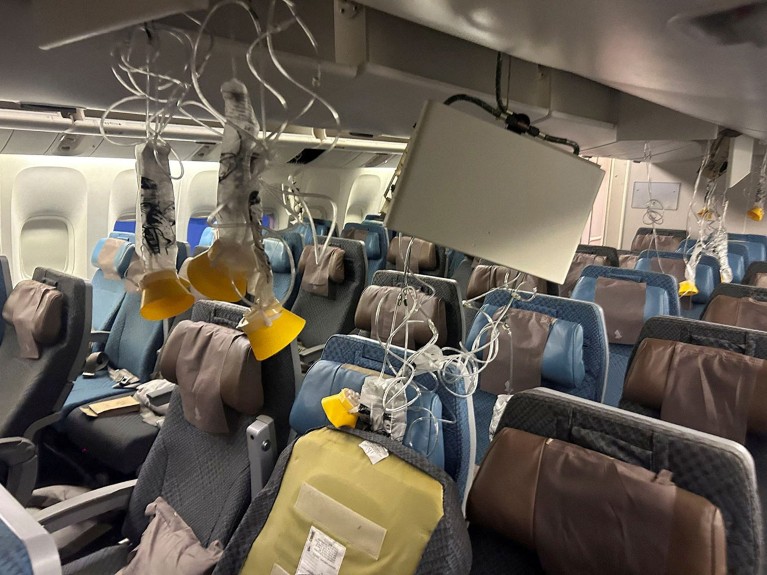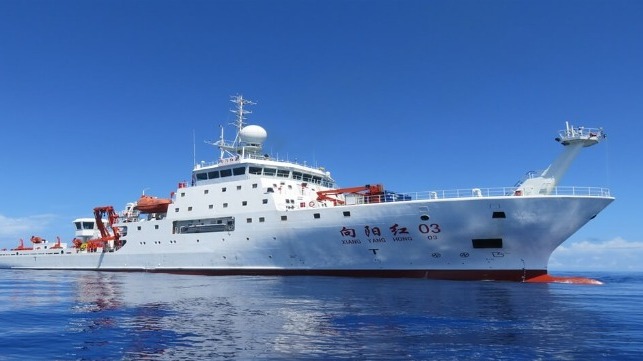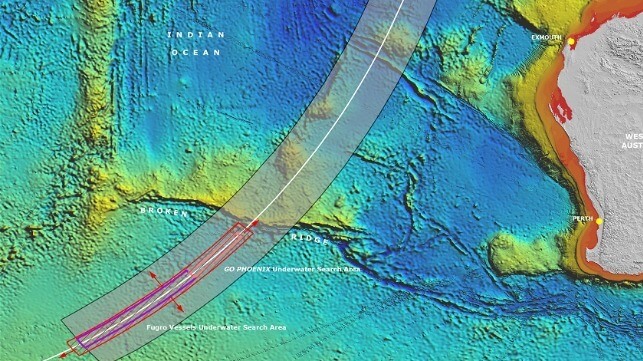Warming temperatures are likely to mean that more of your plane ride will have rocky conditions, creating potentially dangerous situations.
By Carissa Wong
NEWS EXPLAINER
22 May 2024

Emergency masks were deployed during the Singapore Airlines flight that experienced severe turbulence this week, killing one man.Credit: Reuters
Severe turbulence on a Singapore Airlines flight from London to Singapore has left a 73-year-old man dead and injured more than 70 people. The incident, although rare, is raising questions about what caused such a serious disruption to the flight — and whether climate change will make the strength and frequency of turbulence on planes worse.
The plane, which departed on 20 May, experienced a sudden drop of around more than 1,800 metres that launched people and objects towards the cabin roof. It is the airline’s first fatal incident in 24 years.
“Severe turbulence is the one that turns you into a projectile,” says atmospheric researcher Paul Williams at Reading University, UK. “For anyone not wearing a seatbelt it would have been a bit like being on a rollercoaster without any restraint in place — it would have been terrifying,” he says.
Nature looks at the science of air turbulence and how climate change will influence it.
What causes turbulence in aeroplanes?
Most flights experience some level of turbulence. Near the ground, strong winds around the airport can cause turbulence as planes take off or land. At higher altitudes, up- and downwards flows of air in storm clouds can cause mild to severe turbulence as planes fly through or near them. “Nobody likes flying through a storm,” says Williams.
Air flows that move upwards over mountain ranges can also create turbulence. “As the air blows over the mountain, the plane gets lifted up and can become turbulent,” says Williams. Moreover, turbulence often occurs on the edges of jet streams, which are strong air currents that circle the globe. Any turbulence that occurs outside of clouds is called “clear air” turbulence. It could take weeks to establish what kind of turbulence caused the Singapore Airlines incident, says Williams. “Provisionally, there was a storm nearby, but also the conditions were right for clear air turbulence — we need to do some more digging before we can say,” he says.

Damage in the galley of the Singapore Airlines Boeing 777 aeroplane.Credit: Reuters
Is climate change making turbulence worse and more frequent?
Climate change is making turbulence more frequent and severe, says atmospheric researcher Jung-Hoon Kim at Seoul National University.
In a study published last year1, Williams and his colleagues found large increases in clear-air turbulence between 1979 and 2020. Over the North Atlantic, severe clear-air turbulence — which is stronger than Earth’s gravity — became 55% more frequent. There were similar increases in turbulence all over the world, he says. The increase is almost certainly the result of climate change, which is strengthening the jet streams that cause turbulence, says Williams. “We already know it’s having an impact,” he says.
In another study2, Williams and his colleagues used a climate model to predict that clear-air turbulence would become more severe and frequent as the climate warms. The researchers estimated that severe turbulence would increase in frequency more than light or moderate levels of turbulence. In line with this, Kim and his colleagues found that clear-air turbulence around clouds and mountains would become more frequent with climate change, in a study published last year.
Despite the probable rise in turbulence, most flights will carry on as they do now — with light or mild turbulence, says Williams. “It is not that we’ll have to stop flying, or planes will start falling out of the sky,” says Williams. “I’m just saying that for every 10 minutes, you’ve spent in severe turbulence in the past, it could be 20 or 30 minutes in the future,” says Williams.
Can we predict and prevent bad turbulence?
Pilots use turbulence projections to plan flight paths. Researchers at weather centres can predict turbulence based on data collected from ground-based sensors and satellites and communicate predictions to pilots. On the plane, pilots use radar to identify storm clouds to avoid. This relies on radiowaves being sent out from the aircraft, which are then reflected back towards sensors that map out the surrounding area.
But radar cannot detect cloudless clear air turbulence. Another technology called LiDAR could help, says Williams. “LiDAR is similar to radar but uses a different wavelength of light,” says Williams, “Unfortunately it’s expensive, and requires a big heavy box, but it can see invisible clear air turbulence.” If the box can be miniaturised and the cost comes down, it could soon be used, he says. “I’ve seen some experimental flights, and you can indeed see clear air turbulence 20 miles, for example, ahead of the aircraft,” he says.
Until then, “I hope that everybody when they travel, please fasten your seat belts,” says Kim.
doi: https://doi.org/10.1038/d41586-024-01542-2
References
Prosser, M. C., Williams, P. D., Marlton, G. J. & Harrison, R. G. Geophys. Res. Lett. 50, e2023GL103814 (2023).
Storer, L. N., Williams, P. D. & Joshi, M. M. Geophys. Res. Lett. 44, 9976–9984 (2017).


















